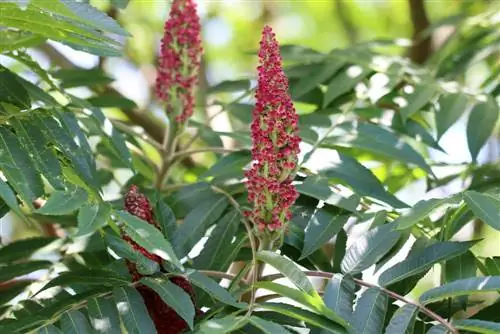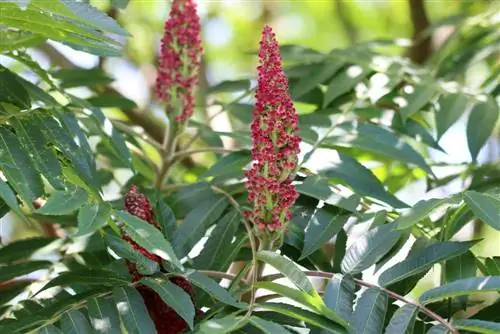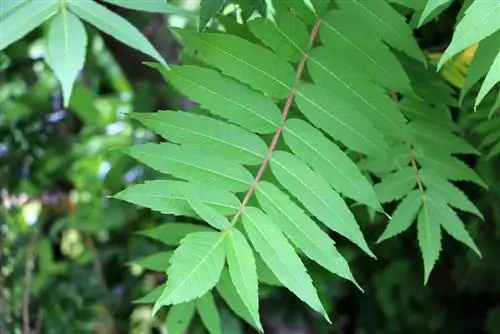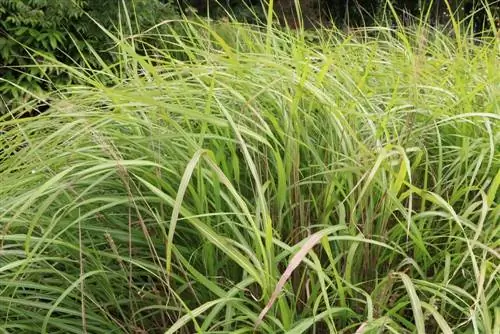- Author admin [email protected].
- Public 2023-12-17 03:39.
- Last modified 2025-06-01 06:48.
Vinegar trees are considered very undemanding plants and impress with their strong growth. However, this is not always desirable because the trees and their roots tend to spread very quickly. To keep Rhus typhina under control, its growth should be curbed. We have summarized how this works best for you in this article!
Why contain vinegar tree?
Vinegar trees are not only characterized by their decorative appearance, because they also form a considerable root system. The main root often extends up to two meters deep and also forms a large number of side shoots. Due to the sprawling root system, it can happen that the vinegar tree conquers the garden in a relatively short time - and over a large area! This not only poses the risk that other plants will be literally driven away, but also that the tree will sprout somewhere else in the garden. The roots can extend up to 10 meters from the mother plant. So that the vinegar tree does not literally “spread out” in the garden, its roots should be contained accordingly.
- Latin name: Rhus typhina
- Synonyms: dyer's tree, deer butt, Gerber's or spice sumac
- Origin: North America
- Growth height: 3 - 6 meters
Note:
All parts of the plant and especially the milky sap are slightly toxic to humans and animals. It is therefore advisable to always wear gloves when working on the tree.
Root barrier
It is advisable to install a root barrier for stoloniferous shrubs and trees. This literally imprisons the roots and prevents them from spreading beyond a certain limit. A film is usually used as a barrier, although an ordinary pond liner can also be used for many plants. However, Rhus typhina requires a slightly stronger film, as its roots are very strong and could pierce “normal” films. It is therefore advisable that the film is at least two millimeters thick. It is best to use a film made of HDPE (high-pressure polyethylene) to contain the vinegar tree, as this cannot be punctured by the roots. In addition, the film should have the following features:
- UV-resistant so that above-ground parts are not damaged by the sun
- frost-resistant, otherwise the root barrier could become porous or brittle
- Rodent resistance so rodents don't chew through them
Note:
The roots of the vinegar tree are actually rhizomes, which is why the root barrier is also known as the “rhizome barrier”.
Instructions
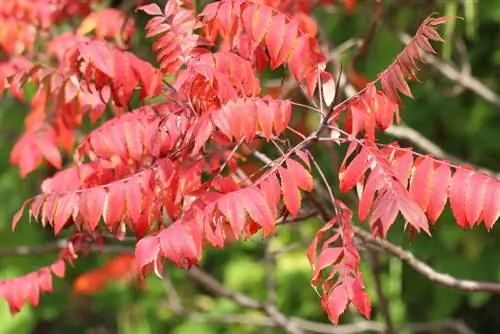
Basically only two utensils are needed for the rhizome barrier, namely the HDPE film, an aluminum rail and screws. The hobby gardener should also have a drill or something similar at hand, as holes will later be drilled into the rail. The barrier itself is usually created in a circle around the plant, with a radius of around two meters being taken into account. If the distance is smaller, it will constrict the tree too much, so that it may even die as a result. But the root depth must also be taken into account, as the roots of the vinegar tree can extend up to two meters deep. For this reason, the depth of the film should be around 40 to 60 centimeters.
- Perimeter: 2 m
- Depth: 40 - 60 cm
- Completely enclose the plant with foil
- Overlap the end of the film at least 10 cm
- Close lock with aluminum rail
- Drill holes in two overlapping places
- Screw the rail there
- Fill the space with soil
In general, it is advisable to install the barrier before planting. Although it is possible to subsequently contain vinegar trees, it is not necessarily recommended. To do this, the root runners would have to be severed first, which, however, stimulates the roots' urge to spread even more and thus promotes growth.
Containment with culture in a bucket
There is basically nothing wrong with cultivating a vinegar tree in a pot. The advantage here is that the root depth is limited by the pot and growth is therefore restricted accordingly. The Rhus typhina cannot spread unhindered, but it will not grow very large and can even age prematurely. It is therefore not recommended to cultivate the tree permanently in a pot. However, the plant survives the first few years of life in the planter without any problems, provided it meets certain requirements. So that the tree does not literally blow up the pot, the container should have the following properties:
- not off sound
- Capacity of at least 10 liters
- Water drain
Note:
It is advisable to transplant the tree into a larger pot every two years.
Care in the pot
The vinegar tree is considered very undemanding because its branched root system extracts sufficient quantities of both water and nutrients from the soil. However, the supply of water and nutrients in the pot is limited, which is why the hobby gardener should support the supply a little. It is also advisable to prune the tree at regular intervals. This care measure not only brings the tree into shape, but also reduces the risk of baldness. In the first years of life, hobby gardeners should therefore take the following care steps to heart:
- Always keep the substrate slightly moist
- It's best to water with low-lime water
- remove excess water
- Avoid waterlogging
- fertilize annually in spring
- for example with nettle manure or compost
- Pruning in spring or autumn

